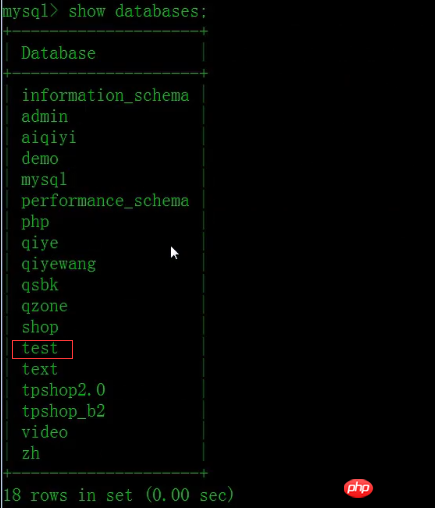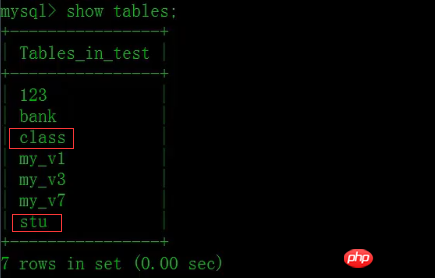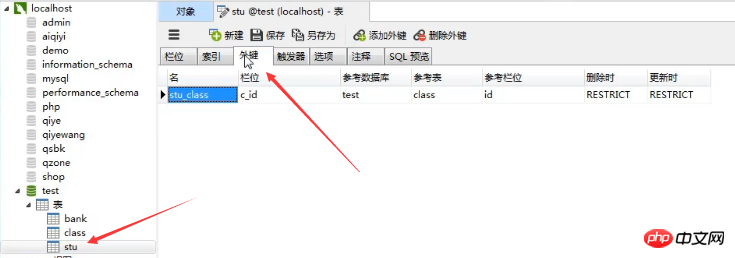 Daily Programming
Daily Programming
 Mysql Knowledge
Mysql Knowledge
 How to add foreign keys to Mysql data table? (Pictures + Videos)
How to add foreign keys to Mysql data table? (Pictures + Videos)
How to add foreign keys to Mysql data table? (Pictures + Videos)
This article mainly introduces how to add foreign keys to mysql data table.
So in the previous article [How to create foreign keys in mysql database? ] has introduced to you the method of mysql creating foreign keys, that is, mysql setting foreign keys when creating tables.
If you want to know more about mysql foreign keys, you can also refer to these two articles:
[What are Mysql foreign keys? What are the uses? 】
【How to use mysql foreign keys? Introduction to the use of foreign keys in Mysql database 】
Let’s use a simple example to give you a detailed introduction on how to add foreign keys to mysql data tables.
First open and query our existing database through the command line tool

Then select use test this database.

Then query the existing data table.

Execute the following command statement to add foreign keys. Here we add a foreign key to the stu table.

Note, The main syntax for adding foreign keys:
alter table +表名+add [constanint + 外键名字]+ foreign key(外键字段) + references 外部表名(主键字段);
Finally we can use Navicat (database management tool) to be more intuitive Check whether the foreign key is added successfully.

As shown in the figure, the foreign key, that is, the c_id foreign key field, has been successfully added to the stu table.
Note: Navicat is a set of fast, reliable and relatively cheap database management tools, designed to simplify database management and reduce system management costs. And is built with an intuitive graphical user interface that allows you to create, organize, access and share information in a secure and simple way.
This article is about the specific method of adding foreign keys to Mysql data table. It is simple and easy to understand. I hope it will be helpful to friends in need!
So about the Navicat database management tool mentioned in the article, friends who are interested can also read the previous related Navicat articles:
[How about Navicat Import and export sql files? 】
If you want to know more about mysql, you can follow the PHP Chinese website mysql video tutorial, everyone is welcome to refer to and learn!
The above is the detailed content of How to add foreign keys to Mysql data table? (Pictures + Videos). For more information, please follow other related articles on the PHP Chinese website!

Hot AI Tools

Undresser.AI Undress
AI-powered app for creating realistic nude photos

AI Clothes Remover
Online AI tool for removing clothes from photos.

Undress AI Tool
Undress images for free

Clothoff.io
AI clothes remover

AI Hentai Generator
Generate AI Hentai for free.

Hot Article

Hot Tools

Notepad++7.3.1
Easy-to-use and free code editor

SublimeText3 Chinese version
Chinese version, very easy to use

Zend Studio 13.0.1
Powerful PHP integrated development environment

Dreamweaver CS6
Visual web development tools

SublimeText3 Mac version
God-level code editing software (SublimeText3)

Hot Topics
 1378
1378
 52
52
 What are stored procedures and functions in MySQL?
Mar 20, 2025 pm 03:04 PM
What are stored procedures and functions in MySQL?
Mar 20, 2025 pm 03:04 PM
The article discusses stored procedures and functions in MySQL, focusing on their definitions, performance benefits, and usage scenarios. Key differences include return values and invocation methods.
 How do you secure your MySQL server against unauthorized access?
Mar 20, 2025 pm 03:20 PM
How do you secure your MySQL server against unauthorized access?
Mar 20, 2025 pm 03:20 PM
The article discusses securing MySQL servers against unauthorized access through password management, limiting remote access, using encryption, and regular updates. It also covers monitoring and detecting suspicious activities to enhance security.
 How do you use roles to manage user permissions?
Mar 20, 2025 pm 03:19 PM
How do you use roles to manage user permissions?
Mar 20, 2025 pm 03:19 PM
The article discusses using roles to manage user permissions efficiently, detailing role definition, permission assignment, and dynamic adjustments. It emphasizes best practices for role-based access control and how roles simplify user management acr
 How do you grant permissions to execute stored procedures and functions?
Mar 20, 2025 pm 03:12 PM
How do you grant permissions to execute stored procedures and functions?
Mar 20, 2025 pm 03:12 PM
Article discusses granting execute permissions on stored procedures and functions, focusing on SQL commands and best practices for secure, multi-user database management.
 How do you set passwords for user accounts in MySQL?
Mar 20, 2025 pm 03:18 PM
How do you set passwords for user accounts in MySQL?
Mar 20, 2025 pm 03:18 PM
The article discusses methods for setting and securing MySQL user account passwords, best practices for password security, remote password changes, and ensuring compliance with password policies.
 How do you grant privileges to a user using the GRANT statement?
Mar 20, 2025 pm 03:15 PM
How do you grant privileges to a user using the GRANT statement?
Mar 20, 2025 pm 03:15 PM
The article explains the use of the GRANT statement in SQL to assign various privileges like SELECT, INSERT, and UPDATE to users or roles on specific database objects. It also covers revoking privileges with the REVOKE statement and granting privileg
 How do you use variables in stored procedures and functions?
Mar 20, 2025 pm 03:08 PM
How do you use variables in stored procedures and functions?
Mar 20, 2025 pm 03:08 PM
The article discusses using variables in SQL stored procedures and functions to enhance flexibility and reusability, detailing declaration, assignment, usage, scope, and output. It also covers best practices and common pitfalls to avoid when using va
 What are the different types of privileges in MySQL?
Mar 20, 2025 pm 03:16 PM
What are the different types of privileges in MySQL?
Mar 20, 2025 pm 03:16 PM
Article discusses MySQL privileges: global, database, table, column, routine, and proxy user types. It explains granting, revoking privileges, and best practices for secure management. Over-privileging risks are highlighted.



